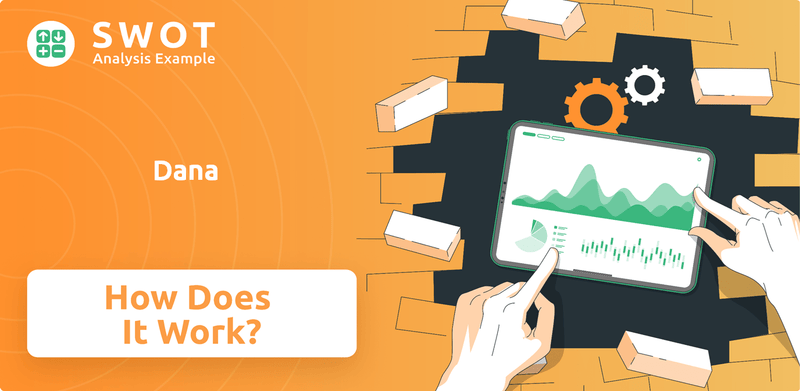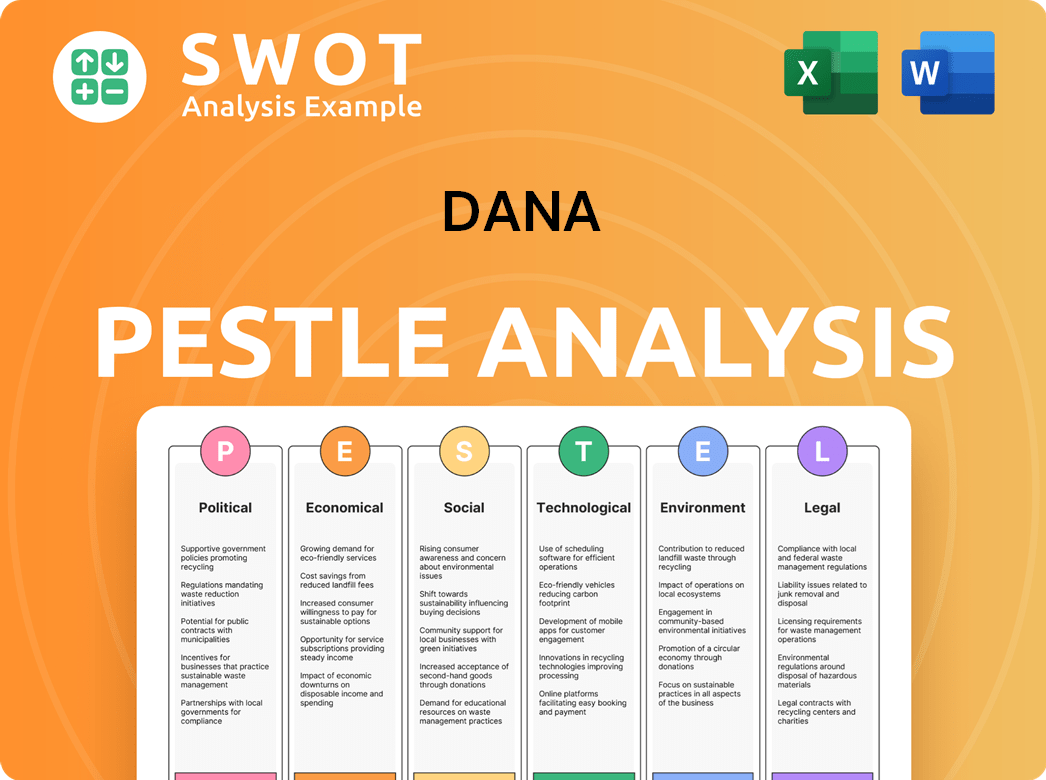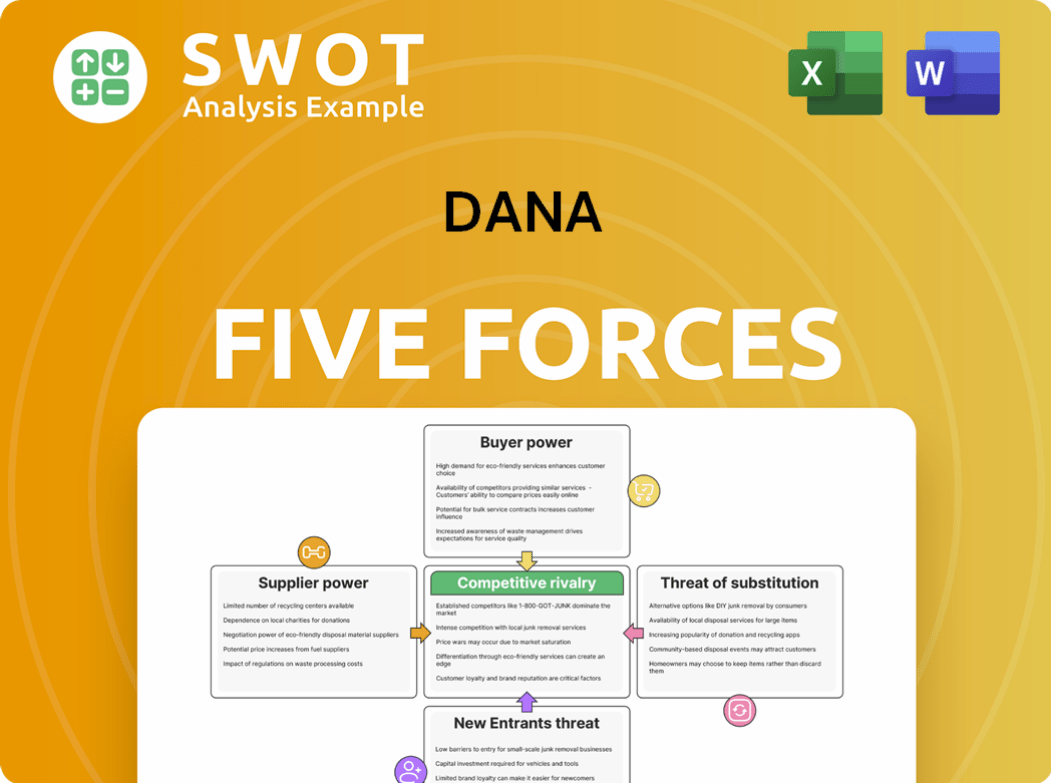Dana Bundle
How Does Dana Incorporated Drive the Future of Mobility?
Dana Incorporated, a global leader in power-conveyance and energy-management solutions, plays a vital role in shaping the automotive and industrial sectors. With over a century of experience, Dana has become an indispensable partner for manufacturers across various markets, consistently adapting to industry advancements. Its impressive financial performance, including $10.6 billion in sales in 2023, underscores its significant market presence and the ongoing demand for its innovative technologies.

To truly understand Dana's impact, we'll explore its Dana SWOT Analysis, business model, and revenue streams. This deep dive is crucial for investors seeking to understand Dana's growth potential and for industry observers tracking market trends. We will examine its
What Are the Key Operations Driving Dana’s Success?
Dana Incorporated, often referred to as the Dana Company, creates value by providing highly engineered power-conveyance and energy-management solutions. These solutions are designed to improve the efficiency, performance, and sustainability of vehicles and machinery. The company's core focus areas include driveline systems, electrification technologies, and sealing and thermal-management solutions.
The Dana business model is centered on serving a diverse customer base. This includes original equipment manufacturers (OEMs) in the light vehicle, commercial vehicle, and off-highway markets, as well as the aftermarket for replacement parts. Dana products and Dana services are integral to the automotive and industrial sectors, supporting a wide range of applications.
Dana operations are characterized by vertical integration and advanced technology. The company manages research and development, design, manufacturing, and global distribution. This approach allows for innovation in areas such as e-Propulsion systems for electric vehicles and advanced thermal-management solutions. Manufacturing facilities are strategically located worldwide to ensure efficient production and delivery.
Dana provides a comprehensive portfolio including driveline systems, electrification technologies, and sealing and thermal-management solutions. These offerings are designed to enhance vehicle performance and reduce emissions. The company focuses on delivering integrated solutions that meet diverse customer needs.
Dana serves OEMs in light vehicle, commercial vehicle, and off-highway markets, as well as the aftermarket. The company's products are essential for various vehicle types and industrial applications. This broad customer base supports Dana's global operations and market presence.
Dana's operational processes include research and development, design, manufacturing, and global distribution. The company utilizes advanced engineering expertise to develop innovative solutions. Strategic manufacturing locations and a robust supply chain ensure efficient production and delivery.
Dana's value proposition centers on improved fuel efficiency, reduced emissions, enhanced vehicle performance, and increased uptime. The company's focus on electrification, including complete e-Propulsion systems, positions it as a key player in the transition to electric mobility. Dana's solutions contribute to sustainable and efficient vehicle operations.
Dana's comprehensive portfolio of integrated solutions sets it apart from many competitors. The company is a leader in providing complete e-Propulsion systems, including e-axles, e-transmissions, and inverters, crucial for electric mobility. Its global footprint and long-standing OEM relationships facilitate close collaboration and tailored solutions.
- Complete e-Propulsion Systems: Dana offers integrated e-axles, e-transmissions, and inverters.
- Global Footprint: Manufacturing facilities and customer support worldwide.
- OEM Partnerships: Close collaboration with major OEMs for product development.
- Customer Benefits: Improved fuel efficiency, reduced emissions, and enhanced vehicle performance.
Dana SWOT Analysis
- Complete SWOT Breakdown
- Fully Customizable
- Editable in Excel & Word
- Professional Formatting
- Investor-Ready Format

How Does Dana Make Money?
The core of the Dana's business model revolves around generating revenue through the sale of its engineered power-conveyance and energy-management solutions. These solutions are primarily sold to original equipment manufacturers (OEMs) and the aftermarket. The company's ability to provide high-value, technologically advanced products is central to its monetization strategies.
In 2023, the company reported total sales of approximately $10.6 billion. This revenue is derived from four main business segments: Light Vehicle Drive Systems, Commercial Vehicle Drive Systems, Off-Highway Drive and Motion Systems, and Power Technologies. Each segment contributes to the overall financial performance of the business, with product sales forming the bulk of the revenue streams.
Dana Incorporated leverages its global manufacturing footprint and engineering capabilities to serve a diverse customer base, often securing long-term supply agreements. The company also benefits from aftermarket sales, which offer a more stable revenue stream than new equipment sales. Furthermore, Dana has expanded its revenue sources through its growing electrification portfolio, particularly in the development and sale of e-propulsion systems.
The primary revenue streams for Dana are derived from product sales across its four business segments. Monetization is achieved through the integration of high-value solutions into customers' products and leveraging a global presence. The company's focus on technological advancement and long-term supply agreements with major OEMs supports its financial performance.
- Product Sales: The main source of revenue comes from selling axles, driveshafts, braking systems, and other components to OEMs and the aftermarket.
- Aftermarket Sales: Replacement parts and service solutions provide a more stable revenue stream.
- Electrification Portfolio: Development and sale of e-propulsion systems and components for electric and hybrid vehicles contribute to revenue growth.
- Global Presence: Serving a diverse customer base through a global manufacturing and engineering network.
- Long-Term Agreements: Securing long-term supply agreements with major OEMs ensures a consistent revenue stream.
Dana PESTLE Analysis
- Covers All 6 PESTLE Categories
- No Research Needed – Save Hours of Work
- Built by Experts, Trusted by Consultants
- Instant Download, Ready to Use
- 100% Editable, Fully Customizable

Which Strategic Decisions Have Shaped Dana’s Business Model?
Dana Incorporated's journey has been marked by strategic shifts and key milestones, particularly in response to the evolving automotive and mobility landscape. The company has consistently adapted its operations and product offerings to meet industry demands, with a strong emphasis on innovation and sustainability. Its evolution reflects a commitment to staying ahead of technological advancements and market trends.
A core strategic focus for Dana has been its aggressive expansion into the electric vehicle (EV) market. This has involved significant investments in e-Propulsion technologies, including e-axles, e-transmissions, and inverters. These moves have positioned Dana as a critical supplier in the rapidly growing EV sector, allowing it to capitalize on the increasing demand for sustainable mobility solutions. This focus on electrification is a key element of Dana's long-term growth strategy.
The company's ability to navigate operational challenges, such as supply chain disruptions, has also been crucial. By optimizing its global manufacturing footprint and strengthening supplier relationships, Dana has demonstrated resilience in maintaining production and meeting customer demand. For instance, despite industry-wide supply chain constraints in 2023, Dana managed to achieve $10.6 billion in sales, indicating its ability to mitigate external pressures.
Dana has consistently adapted to market changes, with a strong focus on innovation and sustainability. The company's strategic moves have been pivotal in its growth and adaptation to the evolving automotive industry. Dana's history shows a commitment to technological advancement and responding to market demands.
Dana has aggressively expanded into the electric vehicle market, investing in e-Propulsion technologies. These investments have positioned Dana as a key supplier in the growing EV sector. The company has optimized its global manufacturing footprint and strengthened supplier relationships.
Dana's deep engineering expertise and intellectual property in driveline and thermal-management technologies provide a significant barrier to entry. The company's global scale and manufacturing capabilities allow for cost-effective production. Dana's long-standing relationships with major global OEMs create a strong customer base.
Dana offers integrated systems, differentiating it from competitors by providing comprehensive solutions. Adaptation to trends like electrification and automation is a key competitive edge. Dana continues to invest in R&D to bring next-generation technologies to market, ensuring its relevance and leadership in the industry.
Dana's competitive advantages are multifaceted, stemming from its technological expertise, global scale, and strong customer relationships. Its deep engineering expertise and intellectual property in driveline and thermal-management technologies provide a significant barrier to entry for new competitors. The company's global manufacturing capabilities allow for economies of scale, enabling cost-effective production and competitive pricing.
- Deep Engineering Expertise: Dana possesses significant expertise in driveline and thermal-management technologies.
- Global Scale and Manufacturing: The company's extensive manufacturing capabilities enable cost-effective production.
- Strong Customer Relationships: Long-standing relationships with major global OEMs create a strong customer base.
- Integrated Systems Approach: Dana offers integrated systems rather than just components, providing comprehensive solutions.
Dana Business Model Canvas
- Complete 9-Block Business Model Canvas
- Effortlessly Communicate Your Business Strategy
- Investor-Ready BMC Format
- 100% Editable and Customizable
- Clear and Structured Layout

How Is Dana Positioning Itself for Continued Success?
Dana Incorporated holds a strong position in the automotive and industrial sectors, especially in power-conveyance and energy-management solutions. Its significant market share is supported by a broad product portfolio, global manufacturing presence, and long-standing relationships with major original equipment manufacturers (OEMs) across various markets. Dana is recognized as a top-tier supplier in driveline systems and has significantly strengthened its position in electrification technologies. The company's reputation for quality, innovation, and reliable delivery drives customer loyalty.
Despite its strengths, Dana faces risks from regulatory changes, increasing competition, and technological disruptions. Global economic downturns, supply chain issues, and raw material cost fluctuations also pose ongoing challenges. The company's future hinges on successfully executing its electrification strategy, navigating supply chain complexities, and delivering high-value solutions to its diverse customer base.
Dana Incorporated is a leading supplier of drivetrain and e-propulsion systems. It has a strong global presence, serving light vehicle, commercial vehicle, and off-highway markets. The company's focus on innovation and customer relationships supports its market position.
Key risks include stringent emission standards, competition in electrification, and technological advancements. Economic downturns and supply chain disruptions also pose challenges. Fluctuations in raw material costs can impact profitability.
Dana is focusing on electrification, global expansion, and strategic partnerships. The company aims to be a leader in e-Propulsion and thermal management. Success depends on executing its electrification strategy and navigating supply chain challenges.
Dana's strategy involves investing in electrification, expanding its global footprint, and forming strategic partnerships. The company is committed to innovation and delivering high-value solutions. This approach aims to capitalize on industry transformation.
Dana's strategic initiatives are centered around e-Propulsion and advanced thermal management, which are critical for future growth. The company is actively expanding its global presence and seeking strategic partnerships to enhance its product offerings. The focus remains on delivering high-value solutions to a diverse customer base.
- Investment in Electrification Technologies
- Global Footprint Expansion
- Strategic Partnerships
- Focus on e-Propulsion and Thermal Management
The Marketing Strategy of Dana reflects its commitment to innovation and customer satisfaction. Dana's ability to adapt to the changing automotive landscape will determine its long-term success. The company’s investments in research and development are crucial for maintaining its competitive edge. Dana's focus on sustainability and environmental initiatives is also an important aspect of its future outlook. As of early 2024, the company continues to navigate industry challenges while pursuing growth opportunities in electrification and other advanced technologies. Dana Incorporated's operational strategies and financial reports show a commitment to adapting to market changes.
Dana Porter's Five Forces Analysis
- Covers All 5 Competitive Forces in Detail
- Structured for Consultants, Students, and Founders
- 100% Editable in Microsoft Word & Excel
- Instant Digital Download – Use Immediately
- Compatible with Mac & PC – Fully Unlocked

Related Blogs
- What are Mission Vision & Core Values of Dana Company?
- What is Competitive Landscape of Dana Company?
- What is Growth Strategy and Future Prospects of Dana Company?
- What is Sales and Marketing Strategy of Dana Company?
- What is Brief History of Dana Company?
- Who Owns Dana Company?
- What is Customer Demographics and Target Market of Dana Company?
Disclaimer
All information, articles, and product details provided on this website are for general informational and educational purposes only. We do not claim any ownership over, nor do we intend to infringe upon, any trademarks, copyrights, logos, brand names, or other intellectual property mentioned or depicted on this site. Such intellectual property remains the property of its respective owners, and any references here are made solely for identification or informational purposes, without implying any affiliation, endorsement, or partnership.
We make no representations or warranties, express or implied, regarding the accuracy, completeness, or suitability of any content or products presented. Nothing on this website should be construed as legal, tax, investment, financial, medical, or other professional advice. In addition, no part of this site—including articles or product references—constitutes a solicitation, recommendation, endorsement, advertisement, or offer to buy or sell any securities, franchises, or other financial instruments, particularly in jurisdictions where such activity would be unlawful.
All content is of a general nature and may not address the specific circumstances of any individual or entity. It is not a substitute for professional advice or services. Any actions you take based on the information provided here are strictly at your own risk. You accept full responsibility for any decisions or outcomes arising from your use of this website and agree to release us from any liability in connection with your use of, or reliance upon, the content or products found herein.